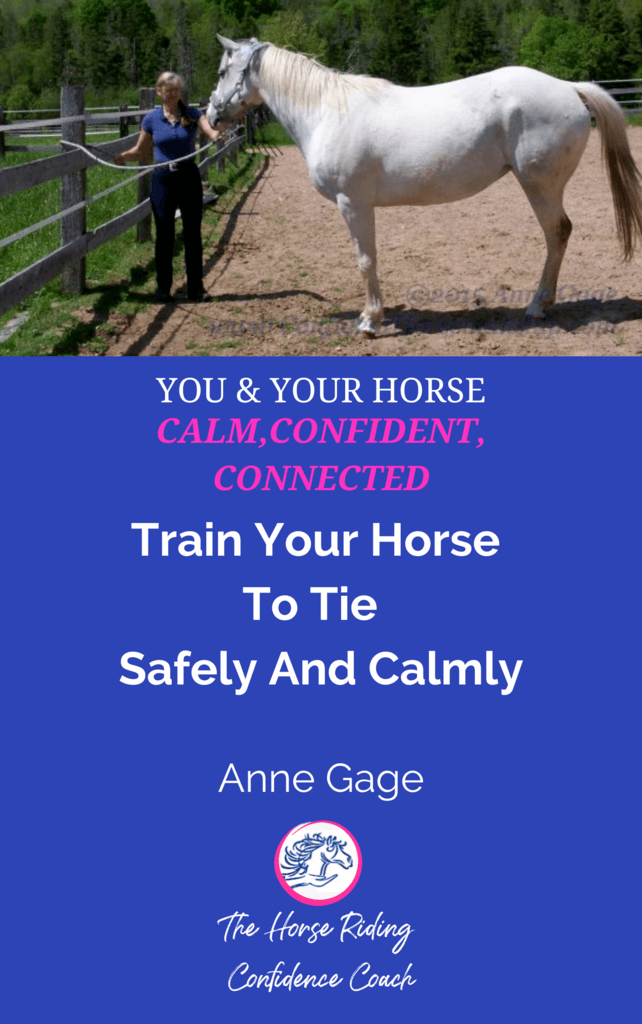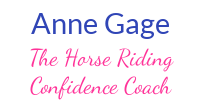DISCLOSURE: THIS ARTICLE CONTAINS AFFILIATE LINKS, MEANING I GET A COMMISSION IF YOU DECIDE TO MAKE A PURCHASE THROUGH MY LINKS, AT NO COST TO YOU. I ONLY RECOMMEND PRODUCTS THAT I BELIEVE WILL BE USEFUL TO YOU
In Teach Your Horse to Tie Calmly and Safely Part 1 – Giving to Pressure, I explained why horses pull back and even panic when tied, and how to teach your horse the basic foundation behaviours of:
- giving to pressure on the halter
- moving forward from your driving cue to his flank
- standing straight, square and level even when you move away from him
In part 2, I’ll take you through the final steps of training your horse to be tied safely and calmly.
REMEMBER: Only when your horse consistently stands quietly and gives to pressure on his poll should you attempt to tie him. If your horse does not have these two traits yet, read the previous article for how to prepare your horse for being tied.
A word of warning: working with a horse that has learned to break away or panics when tied can be dangerous. Be honest about your own ability, skill level, and confidence. If you’re out of your depth then get help from an experienced trainer who doesn’t offer quick fixes, and will work with you and your horse together.
Training The Move Forward From A Pushing Cue Before Tying Your Horse
- Stand to the side and slightly in front of your horse at about a 45-degree angle with your centre (navel) aimed towards his body.
- Take up contact on the rope. Ask your horse to step forward by pushing into his flank with your whip or end of the rope.
- Be sure that you are not sending any pushing movements in front of his shoulder or into his head. That would stop him from coming forward and you would be giving him a mixed message of “go forward but don’t go forward” which will confuse him and can cause panic as he will be in a “no-win” situation.
- Stop pushing as soon as your horse takes a step forward.
- Reward him with a soft voice and by stroking his withers or with a small food treat.
Training To Stand In Place Before Tying Your Horse
You’ll begin with your horse standing quietly in a calm frame. Then you’ll ask him to stay in place while you move away.
- Give him the visual signal to stay by pointing at his chest as you step away. And give him a voice cue (e.g. stand or stay)
- If your horse follows you, calmly correct him by asking him to step back or walking him back to the same place he started from.
- Give him the “stand” cue again.
- Expect to repeat this step a number of times.
- Catch your horse staying in place even if it’s just for one second. Reinforce him with a soft voice and a scratch on the withers or a small food reward.
- As your horse figures out what you are asking and stays in place, gradually expand the distance between you to about 6 feet. (This is the foundation of teaching your horse to ground tie.)
Ready to Tie Your Horse Safely and Calmly
To keep yourself and your horse safe, you’ll need:
- an area clear of anything your horse might bump into or step on
- safe footing that your horse will not slip or stumble on
- a secure object to tie him to (e.g. fence post or securely fixed tie ring) at or slightly above the level of his back
- a quick release snap or Blocker Tie Ring (or be able to tie a quick release knot)
- a long cotton lead rope in good condition that allows your horse to stand about 2 feet away from what he is tied to. He should be able to move a bit but not get tangled
- a well-fitted web break-away or leather halter in good condition. Do not use a rope halter as it won't break and can cause injury to your horse's poll or neck.
- With your horse in a calm frame and standing a couple of feet away from where he will be tied, put the end of the rope through the ring or around the post and hold the end. Do not tie the rope yet.
- If your horse pulls back, hold the rope to create a blocking pressure (do not pull) and give him the step forward cue to his flank. If he steps forward, he will release the pressure on the rope.
If he panics and continues to pull back, release your block and let the rope slide through your hand. When he feels the pressure release, he will stop pulling back.
Ensure he is calm before starting again.
- Only when your horse stands quietly and consistently gives to pressure on his poll should you tie the rope. Always use a quick-release knot or a quick-release clip
- Attach the quick release clip to the tie ring rather than to your horse’s halter. If your horse panics, you can quickly release the clip without putting yourself in danger of being hurt and still have something to hold onto him with.
- Allow some slack in the rope but not so much that your horse can step on or over it.
- Your horse may test the rope. If he pulls back give him the “go forward” cue just as you did when you were holding the end of the rope.
- If he panics, quickly release the clip or knot to relieve the pressure. Releasing the pressure removes the source of pain or panic. And that dramatically reduces the threat of pain or injury to you and your horse.
Teaching your horse to stand calmly, give to pressure and think rather than react instinctively takes time, patience, and persistence.
But the results are a trusting, confident, and calm partnership that keeps you both safe.
Read the Previous Article (Teach Your Horse To Tie Safely and Calmly Part 1 - Giving to Pressure)
The Bottom Line: When you help your horse feel calm and safe by removing physical and mental stress, your horse will be less likely to panic and will look to you for reassurance.
MINI COURSE
Learn How To Train Your Horse To Tie Calmly and Safely
Whether you're teaching your young horse or re-training a horse who is anxious when tied, in this mini course you'll discover how to:
- Reduce your horse's tension about being tied - without using force or fear.
- Safely introduce your young horse to being tied
- Re-train a horse who won't stand still, pulls back or even panics when tied
- Earn more trust from your horse so you can both feel more calm, confident and connected.
The course includes 6 videos and a PDF format eBook.

